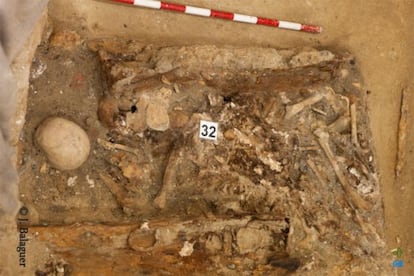“It’s possible that the remains we have found belong to Miguel de Cervantes”
Team trying to identify bones of ‘Don Quixote’ author “convinced we have something”

A team of forensic scientists in Madrid say they have located the remains of Spanish novelist, poet and playwright Miguel de Cervantes Saavedra (1547-1616), but have stopped short of a definitive identification given the lack of DNA evidence.
The scientist in charge of the search for the author of Don Quixote, Francisco Etxebarria, announced on Tuesday that it was “possible” that “some fragments” found belonged to Cervantes, a conclusion his team reached “in light of all of the information generated in historical, archeological and anthropological terms.”

“We have not been able to resolve the mystery with absolute certainty, which is why we are being cautious,” he explained. “We are convinced that we have something. It is possible to consider that among the fragments of [the bones] located in the ground of the crypt in the current Trinitarias church there are some that belong to Miguel de Cervantes.”
The novelist was buried somewhere inside the former convent, located in the capital’s Las Letras neighborhood, on April 23, 1616.
The remains – a jaw bone, as well as several bones from arms and a hip – were located in a severely deteriorated state, and mixed up with those of Cervantes’ wife, Catalina de Salazar. The remains have been identified by a team of around 30 specialists from across Spain using historical and archaeological evidence, but not with DNA. The remains were found in the crypt of the Trinitarias church, in central Madrid, after having been lost for four centuries.
Experts searched the old cloistered convent with the help of ground-penetrating radar, also known as a georadar, which picks up and measures underground cavities uses wave pulses. Since 1870, evidence had been found suggesting that there were undiscovered burial sites beneath the monastery, including one that could belong to an adult man.
Earlier this year, the team discovered a coffin containing bone fragments and bearing the initials “M. C.” inside the religious building in Madrid.
Tu suscripción se está usando en otro dispositivo
¿Quieres añadir otro usuario a tu suscripción?
Si continúas leyendo en este dispositivo, no se podrá leer en el otro.
FlechaTu suscripción se está usando en otro dispositivo y solo puedes acceder a EL PAÍS desde un dispositivo a la vez.
Si quieres compartir tu cuenta, cambia tu suscripción a la modalidad Premium, así podrás añadir otro usuario. Cada uno accederá con su propia cuenta de email, lo que os permitirá personalizar vuestra experiencia en EL PAÍS.
¿Tienes una suscripción de empresa? Accede aquí para contratar más cuentas.
En el caso de no saber quién está usando tu cuenta, te recomendamos cambiar tu contraseña aquí.
Si decides continuar compartiendo tu cuenta, este mensaje se mostrará en tu dispositivo y en el de la otra persona que está usando tu cuenta de forma indefinida, afectando a tu experiencia de lectura. Puedes consultar aquí los términos y condiciones de la suscripción digital.
Últimas noticias
From digital curfews to blocking apps: How technology experts protect their children online
Why the price of coffee has skyrocketed: from Brazilian plantations to specialty coffee houses
Confined to a Cuban hospital: When electricity is a matter of life or death
The complicated life of Francesca Albanese: A rising figure in Italy but barred from every bank by Trump’s sanctions
Most viewed
- Why we lost the habit of sleeping in two segments and how that changed our sense of time
- Pablo Escobar’s hippos: A serious environmental problem, 40 years on
- Trump’s obsession with putting his name on everything is unprecedented in the United States
- The Florida Keys tourist paradise is besieged by immigration agents: ‘We’ve never seen anything like this’
- Charles Dubouloz, mountaineering star, retires at 36 with a farewell tour inspired by Walter Bonatti








































